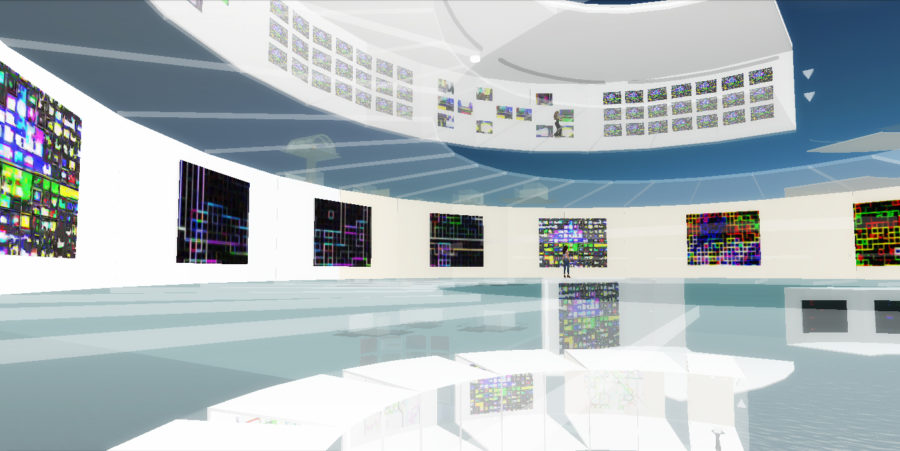Exploring the metaverse and its implications: two perspectives
March 15, 2022
A guide to navigating the metaverse
Kyle Kondas
Kyle Kondas, an Arts & Technology student at the University of Texas at Dallas, held a gallery showing in the Metaverse Gallery on the Arts & Technology Island.
We haven’t fully accepted the idea of a metaverse, yet it’s already being commercialized to increase milk production. How? On Jan. 6, Turkish farmer Izzet Kocak placed his cows in a metaverse to trick them into thinking they were grazing in green summer pastures when, in reality, they were cooped up in small cages.
With open grassy fields and cow-sized virtual reality (VR) goggles, the cow’s anxiety levels declined and they produced more milk than usual. The somewhat disturbing experiment was so successful that more farmers are looking to do the same thing to their cows.
Okay, I admit, that’s probably not what you were expecting to read about when opening an article about the ‘metaverse’. But hear me out. Even though forcing cows into a metaverse feels as though we’re the perpetrators of a new “Matrix” where one species places another into a controlled environment that capitalizes on the other’s energy—er, milk—this weird example goes to show just how influential the metaverse could be in ways we’ve never imagined before.
What the metaverse is
The concept of the metaverse was first coined by Author Neal Stephenson who, in his 1992 cyberpunk novel “Snow Crash,” wrote of a world where people used digital avatars to meet in realistic virtual reality environments to escape a dystopian reality.
Since then, Ernest Cline’s 2011 novel-turned-film “Ready Player One” and Shawn Levy’s “Free Guy” brought the concept of the metaverse to cinemas, enabling people to envision the transformative potential of a gaming metaverse. The films displayed characters such as Wade Watts and Guy who undergo challenges to liberate the Oasis and Free City (the movie’s metaverses) from CEO antagonists.
The meaning of the term ‘metaverse’ is often debated, but it broadly refers to a virtual universe where everyone can exist as digital avatars and interact with one another and with the universe around them. People can interact with the metaverse while utilizing technologies such as VR and augmented reality (AR).
Well-known venture-capitalist Matthew Ball described the metaverse as “an expansive network of persistent, real-time rendered 3D worlds and simulations… can be experienced by an unlimited number of people at the same time, in which everyone will have their own sense of presence.”
For example, video games such as “Fortnite”, “Roblox “and even “Animal Crossing: New Horizons” have shown metaverse-like elements because they all have shared, online spaces where users can interact with one another within their virtual gaming worlds.
How companies are getting involved
The idea of the metaverse isn’t as futuristic as it sounds. Microsoft announced on Jan. 18 that it will advance its metaverse plans by merging with Activision Blizzard, the gaming company that developed games such as Call of Duty and World of Warcraft, for $69 billion, which is the highest price ever paid by a U.S. tech company in an acquisition.
Apart from video games, Facebook, which owns platforms such as Instagram and WhatsApp, announced it was rebranding itself as Meta Platforms to signify its interest in building its own metaverse platform where anyone can “get together with friends and family, work, learn, play, shop [and] create,” CEO Mark Zuckerberg wrote in a founder’s letter. To do this, Meta is developing the world’s fastest AI supercomputer to power the metaverse.
On Jan. 27, Apple CEO Tim Cook teased his metaverse ambitions by discussing the expansion of Apple’s augmented reality apps, causing Apple’s stock price to jump 5% after-hours following an 8-day losing streak.
It’s not only big technology companies getting involved. Startups are also innovating technologies to assist users in the metaverse. For example, Emerge launched the Emerge Home system on Jan 28. The system emits sculpted ultrasonic waves that allow users to feel and touch with their bare hands as controllers.
Additionally, Walmart filed trademark applications on Jan. 16 with plans to create its own virtual currency and sell goods within the metaverse, potentially offering a way for shoppers to buy products in a virtual Walmart supermarket that can then be shipped to homes.
But not all products sold have to exist in real life. Nike filed trademark applications to develop branded clothing apparel that can be used by digital avatars in the metaverse. They also purchased virtual sneaker creator RTFKT and are developing a virtual world known as ‘Nikeland’.
Metaverse of tomorrow
What would a complete metaverse look like in the future? The short answer is that no one truly knows; we can only speculate. Just as it was hard to envision in 1982 what the internet of 2022 would be like, tech analysts find it hard to describe the metaverse.
Maybe the metaverse could ultimately be a place where anything physically possible in reality can be performed in a virtual reality environment, similar to the artificial Earth depicted in the movie “The Matrix.”
Maybe the metaverse could be centered on a solo perspective limited only by your imagination, where you can be an Avenger superhero, travel back in time to live in ancient Egypt or even rule over an alien planet, all without ever leaving your room.
Or maybe the metaverse could be documenting humanity’s most cherished traits and memories, preserving our species forever within an accessible digital footprint, similar to concepts embedded within James Cameron’s “Avatar,” Lois Lowry’s “The Giver” and the animated series “Cowboy Bebop”. Whatever the case, what exists today is nowhere near the potential for the future of the metaverse.
How to get there
For a few years, investors have been pouring into Ethereum-based metaverse platforms (blockchain metaverses built on Ethereum) such as Decentraland and Sandbox, hoping to invest in the metaverse before it becomes too expensive for the average investor. Experts predicting our lives to be fully immersed in the metaverse by the year 2030 have only accelerated the craze.
In fact, interest in digital ownership of the metaverse has spiked dramatically. When celebrity rapper Snoop Dogg bought up land in the virtual world Sandbox for half a million dollars with plans to develop the land known as “Snoopverse,” digital land prices in neighboring areas on the Sandbox map skyrocketed.
Unfortunately, if you were to try these platforms today, you’d be shocked at how underdeveloped the graphics, software and technology is, compared to, for example, Sony’s Playstation games. Indeed, investment into the metaverse may not have gained as much traction as it should have because some investors have been scared away by the 90s-esque video game quality of the platforms.
The poor quality has been a rallying cry for doubters about the potential for development of the metaverse. Some claim the metaverse can never have graphics that mimic the real world as long as users are limited by the internet speeds we have today. Recently, however, those doubts have been washed away with the introduction of 5G networks that could solve slow connection speeds and high latency problems by being 20 times faster than previous internet speeds.
Critics have also found the Ethereum-based metaverse platforms to be very similar to existing video games such as Roblox and Minecraft. The only differences? Real-world applications and a cryptocurrency standard you can use within the platforms as real money. The differences are game changers for users because using virtual currencies within the metaverse that are accepted when paying for real-life goods can help connect the metaverse closer to our daily lives.
Moreover, there’s still much to do if we want a metaverse where you can do ‘anything in a virtual reality environment’. For one, we need AI software that lets you integrate your own ideas into the metaverse rather than standard business conferencing or standard clothes/housing to buy from. Granted, we’re a long way from developing the capabilities to integrate AI into the metaverse, but user created content could still prove important in making the metaverse experience more personalized and intriguing.
Additionally, we need a single decentralized metaverse to make the metaverse space more like the general internet rather than multiple metaverse platforms that are controlled by different companies.
In fact, Ball argued that the metaverse should offer “unprecedented interoperability,” or in other words, users should be able to seamlessly move their avatars and items from one place to another, no matter who runs that particular part of the metaverse. That way, metaverse users would be able to truly interact with one another in ways, such as buying and selling non-fungible tokens (NFTs) or using cryptocurrency like we use paper money today with quick transactions and almost no fees.
Universal interoperability would enable users to trade goods and services in the metaverse as fast as it would hand-to-hand in the real world. You might theoretically be able to bid at a high-end auction of famous NFT memes, then attend a live Jay-Z concert at a different location in the metaverse without having to switch applications or software.
Because they don’t offer universal interoperability, Meta and Microsoft’s new ideas and the Ethereum-based metaverses aren’t true metaverse concepts but are instead interactive platforms that fit into the same internet structure we’ve seen for the past 30 years.
Since the big technology companies haven’t done it yet, I’m sure you’re wondering: is a metaverse with universal interoperability even possible? Epic Games CEO Tim Sweeney thinks so. He sees the metaverse as an extension of elements found within the popular video-game Fortnite, and he wants to use it to break free of the current “walled garden” online model dominated by technology giants such as Google, Facebook and Apple.
The technology is certainly there; NFTs, blockchain and cryptocurrencies such as Ethereum are being employed to help the current metaverse platforms function. However not all metaverses offer NFTs and some metaverses use cryptocurrencies and blockchain technologies that lack interoperability.
Benj Edwards, associate editor for How-to-Geek puts it clearly—“The fundamental technologies that would let people chat, own property, and do business across platforms and devices in a 3D virtual world have not been standardized in a way that makes it possible. To make it happen, it will take widely-adopted communication protocols that don’t exist and reinterpretation of intellectual property law.”
In the past, when new industries emerged, such as search engines, VCRs and HDTVs, there were competing models at first, but ultimately the market solidified around a winning contender that became a standard for the particular industry. In this case, the winning contender need not be a monopoly but instead an agreement to make the metaverse decentralized and shared. Hopefully then we will see widespread adoption, fewer legal barriers and the spark of a true metaverse.
Concerns with the future
You might be wondering: what happens when we fully succumb to an artificial lifestyle instead of living our lives in the real world? Well, nothing really. Because at that point, the metaverse would be our new lives anyways.
Take “Ready Player One” for example. The film’s main protagonist Wade Watts explains that after suffering droughts and riots before the year 2045, “people stopped trying to fix problems and just tried to outlive them.” They decided to spend as much time as possible in the metaverse known as the Oasis. But instead of the plot being about saving humanity from the Oasis, the plot was about saving the Oasis from the antagonist of the movie, CEO Nolan Sorrento.
Just as the introduction of the internet and first smartphones received backlash from individuals who were repulsed by the changes to their daily lives, the metaverse will continue to face similar scrutiny. But in the end, the overall transformative benefits of the metaverse for all users outweigh the harm of potential overuse.
If succumbing to the metaverse is acceptable, then how much time should people spend in the metaverse? As long as you can do everything you can in the real world, interact with everyone you wish, and learn and develop just as you would in real life, you should be able to spend a majority of your time in the metaverse. Granted, people still need time to take care of themselves, eat food, drink water and sleep but any time you would’ve spent at school, working or shopping could instead be done in new ways.

Rikin joined the Tribune because he wanted to write about sports, record a fantasy sports podcast and write about business/economics. Rikin is politically active and believes civic engagement by high school...
The Metaverse: blending surrealism with realism
In 1974, philosopher Robert Nozick wrote about an imaginary machine capable of providing happy experiences that were indistinguishable from real-life possibilities in his book “Anarchy, State, and Utopia”. He discussed whether – when given the choice – humans would choose the machine’s artificial simulation over reality.
Now in 2022, I find myself wondering why anyone would choose reality over a machine that gave them the ability to dream of a world where they could create their own lives, determine their own destiny, and be whoever they wanted to be rather than exist in the body that they did. The machine I’m referring to has now come to life as a far more developed metaverse.
The term was first mentioned in Neal Stephenson’s 1992 novel, “Snow Crash”. It mentioned a 3D virtual world where avatars of real people lived. Similar to Nozick’s machine, it portrayed an escape from reality’s grappling hook: a chance to undo mistakes made in the real world and start afresh.
Though this concept seems advanced, its development may be even more plausible than most think, considering several aspects of the metaverse already exist today. Amongst numerous advancements in technology over the years are augmented and virtual reality. Augmented reality refers to virtual items which are overlaid in a real-world environment, while virtual reality is responsible for the creation of a fully artificial environment. When the two are combined, they produce a visual representation of the physical world – a place many of us have grown accustomed to.
I believe that this virtual world dispenses a positive space of enhanced communication and interaction with others and provides easy access to alternatives of real-life items. However, there is still a long way to go to make it a safe and sustainable platform as an alternative to the physical world.
So how would the mass use of the metaverse impact us?
Envisioning the metaverse:
Let us envision my future 24-hour routine. On average, let’s say I sleep for eight hours and am awake for around 16 hours. Out of these 16 hours, I could choose to split my time equally between the metaverse and reality, eight hours in both worlds.
The possibilities are endless and eight hours a day is more than sufficient to explore them while settling into a daily routine. I may explore the wide array of entertainment that is readily available, or interact virtually with my friends and family living across the world.
As of early 2022, the metaverse is still in its infancy and the technology – such as headsets – used to access the virtual world is also evolving. Two largely used headsets are the Oculus Quest 2 and HP Reverb G2 VR Headsets, both loaded with controllers, in-ear headphones, link cables and facial interface features that help one immerse themselves into a VR environment. However, these headsets are far from perfect. Having to carry their weight for hours on end is a great inconvenience and will cause users to feel dizzy, fatigued, or unbalanced after a certain amount of time. Personally, I would not be able to wear them for the entire eight hours I spend online, without experiencing similar side effects.
Despite all the factors that content creators and coders have to take into consideration while building these platforms, the future of the metaverse is envisioned to provide a variety of surreal experiences.
Entertainment
It’s impossible to evade the metaverse today. I, along with others my age, have grown up in the digital era where playing video games and spending hours online is the new norm. The COVID pandemic further normalized meeting in virtual workspaces and attending virtual events, when venturing outside wasn’t an option. Each one of these metaverse-based activities familiarizes us with the possibility of a world online. Their affordability and accessibility also add to their value.
Take “Fornite” for example, a game that Business of Apps reported as played by 350 million registered users in 2021. The game is solely based in a virtual environment where players team up to battle other characters and imitate real-life actions. Other notable mentions are “Roblox” and “Minecraft” – both based in virtual worlds, similar to “Fortnite”.
Aside from games, the concept of virtual concerts – which was previously lesser-known – has been brought to light during the pandemic. 2020 saw singers such as Dua Lipa and John Legend turn to Instagram and YouTube live streams, to keep performing informally.
However, breakthroughs occurred over the next year and a half, when other world-famous singers such as Ariana Grande, Travis Scott, J Balvin, Lil Nas X and Twenty One Pilots took to gaming platforms “Fortnite” and “Roblox” to host free virtual concerts for their large fanbases.
These concerts seem so much more feasible than concerts in the physical world. Not only were they accessible to a larger audience, but their ingenious use of VR highlighted the flexibility of solutions that the metaverse can provide.
If their popularity continues to grow and people continue transitioning to virtual means of entertainment instead of physical events that are often inaccessible, I foresee even larger VR concerts in our near future.
Communication
The implications of the COVID pandemic restricted our ability to go to a friend’s house or head down to T4 without any qualms about social distancing. While these impositions prove that we often face unsolvable problems within reality, multiple solutions lie within the virtual world.
Instead of traditional methods of communicating online (ie. messaging and calling people), your avatar can be face-to-face with the person you are talking to, in a shared virtual environment. Although video conferencing platforms such as Zoom and Google Meet fulfill the purpose of calls, they do not always enable engaging experiences.
As Meta CEO Mark Zuckerberg shared during his Facebook Connect 2021 event in October 2021, this feature makes it seem like “You’re right in the room together, making eye contact, having a shared sense of space and not just looking at a grid of faces on a screen.”
The idea of togetherness seems impossible after being separated from loved ones in other parts of the world for almost two years, but to me, interacting via the metaverse sounds like the next best thing.
The only qualm about this new method of communication is its effectiveness in communicating emotions and body language. Avatars are depictions of artificial intelligence that do not possess the ability to emote yet. When speaking ‘face-to-face’ with the avatar of another individual on the metaverse, it will be difficult to analyze their intentions and feelings without facial expressions that give it away. This disadvantage restricts users from personally connecting with others.
One way I would go about improving the quality of interactions is by establishing features wherein the user’s facial expressions, body language and mannerisms are evident to others during interactions. This provides an opportunity to create a realistic depiction of oneself and come off a certain way to others.
Apart from communications, the virtual world is set to elevate the affordability of experiences such as virtually traveling and working remotely in different countries. These opportunities offer individuals job experience while giving them the chance to visit different countries and explore the world online, which may not have been possible due to the physical and economic barriers of the real world.
In my opinion, this is beneficial for both employees and employers, as well as the economies of countries that continue to grow. Working in different countries will make individuals more open-minded and aware of the culture and norms around the world.
Careers and opportunities
With a growing need for experts in the field of technology, the metaverse is bound to comply with its own set of necessary job-holders. With that being said, by the time the new generations have grown up and set out into the workforce, traditional jobs may be of lesser importance than they are now.
Amongst numerous positions of responsibility within the development of the virtual world comes the role of research scientists and safety managers, who work alongside each other to ensure the relevance and safety of content being put out on the virtual forum. I believe this role is of utmost importance since critics regard unsafe behavior (data leaks, unsafe interactions with avatars of real people, etc.) as a large concern. Its prioritization might be able to sway more people in favor of the metaverse.
To accomplish their safety goals, safety managers must be aware of the possible uses of different features of the metaverse and ensure that there are no loopholes that can be bypassed and unsafe content which could be exposed to a large scale audience.
Along with this self-check, comes the need for beta-testers. They will have prior access to items in the metaverse and check their functionalities to make sure there are no bugs or incomplete aspects.
Perhaps the most important job of all is to build the world itself. Code must be written to programme different features: cameras and headsets to access, enter and live in the virtual world must be built. Budget planners must work alongside builders to allocate a sum of money towards building each part. Each job is equally as important to ensure that the virtual transition runs smoothly.
The creation of the metaverse
As of early 2022, the metaverse is in the early stages of development and production. It is far from fully formed but many prominent technology companies have a clear vision of what they want to contribute to the virtual world.
One of the largest technology companies in the world, Meta – who rebranded to position themselves as pioneers in the development of the metaverse – have already expanded their line of Oculus headsets to access the world of VR. Apple is following up with headsets that will support both AR and VR capabilities. Platform players such as Microsoft and Epic Games have pledged to aid in the creation of the metaverse while Nvidia agreed to lay the foundation for the code. Each of these creations is necessary to model the metaverse.
Unfortunately, some large companies have been hit with allegations about breaches of privacy in the past. The only way to gain the trust of their audience is by redirecting their collection of data towards areas such as user engagement and community building, instead of monetizing the personal information of users. This will aid research scientists in continuously improving features on the metaverse and protecting the safety of individuals at the same time. In doing so, technology companies will attract a larger audience to their platforms.
In conclusion, the metaverse still has more ground to cover before platforms become fully operational and more and more people begin to use them. Certain factors such as relevance, engagement, safety, security and sustainability need to be considered during their development. Without them, it is impossible to achieve mass usage of the metaverse and begin a steady virtual transition.
As the metaverse starts to eliminate the constraints imposed by the physical world, humans will start to adapt and navigate seamlessly between the surreal and real worlds.

Ananya joined the Tribune to emerge from her comfort zone and write about important topics that she is passionate about. She was the web manager for the last two years. In her free time, she likes to travel,...

